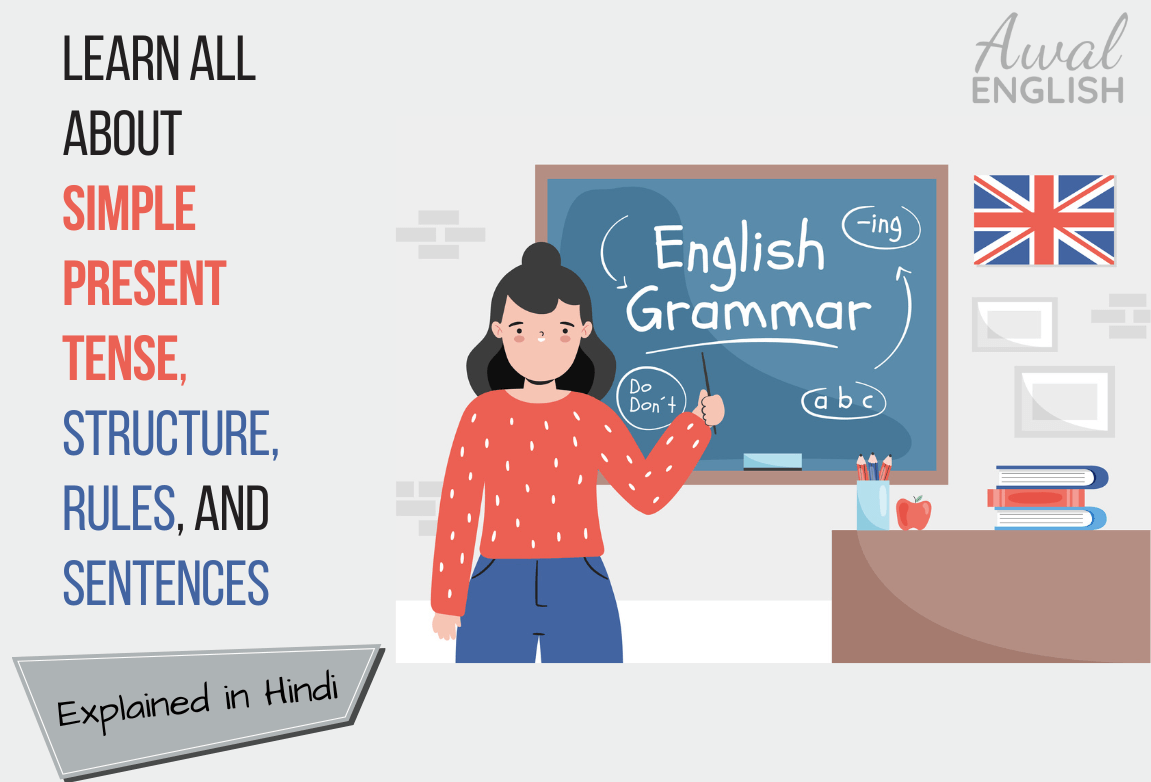
session with mentors
Present Tense: वर्तमान काल
Tenses are known as one of the building blocks of English grammar, and here in this blog, we are going to learn about simple present tense in Hindi. Simple present tense talks about the events occurring regularly, not any event happening at a specific time. In this blog, we will learn every minute detail related to simple present tense like simple present tense formulas, simple present tense rules, simple present tense sentences, etc. Here you will also learn some general rules and points that you must remember while forming simple present tense sentences. This knowledge about simple present tense in Hindi to English will help you learn English speaking online. This blog will help you learn English online, just like learning through a spoken English language course.
सीखें Simple Present Tense बिना Grammar में उलझे through this video
इस blog में आप सीखने वाले हैं present simple tense in Hindi के बारे में जहाँ हम इस simple present tense से जुड़े कुछ नियम, उसके structure और simple present tense sentences के बारे में जानने की कोशिश करेंगे।
What is Simple Present Tense?
Simple present tense in the sentence form shows the time when the time of an action or situation is determined, that is, it is the time in which the regular occurrence of an action is shown. In this period, some simple or permanent truth is often described, such as a work habit, reality of life, etc. The form of verbs in the simple present tense does not change according to the sentence’s subject, but it remains the same for all cases.
Definition of Simple Present Tense
The simple present tense is defined as a tense that is suitable for describing actions or situations that occur commonly, regularly, or commonly in the present time.
Simple present tense वो tense होता है जिसका इस्तेमाल ऐसी स्थिति या actions के बारे में बताने के लिए इस्तेमाल किया जाता है जो वर्तमान या आज के समय में अक्सर या रोज़ होती हैं।
Structure and Formula of Simple Present Tense
The structure of Simple Present Tense is based on the following formula:
Subject + Verb (base form) + Object/Complement
Here,
- The subject is the person or thing that performs the action or is described by the sentence.
- The verb is the action word that shows what the subject is doing or being. In the simple present tense, the verb remains in its base form (the form without any endings or changes).
- And, object or complement is the person or thing affected by the verb’s action, or additional information about the subject.
Simple Present Tense का structure बहुत ही आसान होता है जहाँ subject के साथ verb की base form लगती है और उसके साथ object या complement.
Types of Simple Present Tense
There are four types of Simple Present Tense and these types are given along with their formula below:
1. Assertive Sentence
Formula: Subject +V1 +s/es +Object
- I catch the bus every day.
मैं रोज़ bus पकड़ता हूं।
- He goes for a walk every morning.
वह रोज़ सुबह टहलने जाते हैं।
- She donates money to the orphanage every month.
वह हर महीने अनाथालय को पैसे दान करती है।
- We eat lunch outside every two weeks.
हम हर दो हफ्ते में दोपहर का खाना बाहर खाते हैं।
- He eats cereals for breakfast.
वह नाश्ते में अनाज खाता है।
- The sunsets in the west.
सूर्य पश्चिम में अस्त होता है।
2. Negative Sentence
Formula: Subject +does not/ do not +V1 +s/es +Object
- He does not eat breakfast every day.
वह रोज़ नाश्ता नहीं करता है।
- I do not go jogging.
मैं jogging के लिए नहीं जाता।
- She plays the guitar well.
वह guitar अच्छा बजाती है।
- We do not catch the train every week.
हम हर हफ्ते train नहीं पकड़ते हैं।
- You do not come here often.
आप यहां बार-बार नहीं आते।
- The moon does not shine during the day.
चाँद दिन में नहीं चमकता।
3. Interrogative Sentence
Formula: Does +Subject +V1 +Object
- Does she speak English?
क्या वह अंग्रेजी बोल सकती है?
- Do I go there every day?
क्या मैं रोज़ वहां जाता हूं?
- Do you eat bananas?
क्या आप केले खाते हैं?
- Does he go to the church every Friday?
क्या वह हर शुक्रवार को चर्च जाता है?
- Do you love cricket?
क्या आपको cricket से प्यार है?
- Does it bark loudly?
क्या यह ज़ोर से भौंकता है?
4. Negative Interrogative Sentence
Formula: Does/Do+ Subject+ not+V1+Object.
- Does she not go school?
क्या वह school नहीं जाती है?
- Do you not watch movies in the theatre?
क्या आप theatre में फिल्में नहीं देखते हैं?
- Does he not play guitar?
क्या वह guitar नहीं बजाता?
- Do they not eat pasta for dinner?
क्या वे रात के खाने में पास्ता नहीं खाते हैं?
- Do I not go to the party?
क्या मैं party में नहीं जाता?
- Does she not come here regularly?
क्या वह यहाँ नियमित रूप से नहीं आती?
Some WH Sentences Example of Simple Present Tense
The simple present tense can be used in WH (question words like who, what, where, why, when, and how) sentences to ask questions about actions or states that are habitual, general truths, or scheduled events. The WH word is placed at the beginning of the sentence, followed by the auxiliary verb (do/does) for yes-no questions in English. Some of the examples are given below:
- Where do you go to college?
आप college कहाँ जाते हैं?
- I go to college in Delhi.
- मैं दिल्ली में college जाता हूँ।
- What time does the show start?
Show कितने बजे शुरू होता है?
- The show starts at 8 pm.
- Show रात 8 बजे शुरू होता है।
- How often do you go to English class?
आप कितनी बार अंग्रेज़ी कक्षा में जाते हैं?
- I go to English class twice a week.
- मैं सप्ताह में दो बार अंग्रेज़ी की कक्षा में जाता हूँ।
- When do you plan to visit Jay?
आप जय से मिलने का कब plan बना रहे हैं?
- I am planning to visit her tomorrow.
- मैं कल उससे मिलने का plan बना रहा हूं।
5.Where do you play badminton?
आप badminton कहाँ खेलते हैं?
- I play badminton on the court near to my house.
- मैं अपने घर के पास के court में badminton खेलता हूँ।
What Do You Use Simple Present Tense For?
The simple present tense is used for:
- To express regular actions or habits.
For example: “He exercises every morning.”
- To express reality about something.
For example: “I study urban planning.”
- To refer to actions occurring at a proposed time.
For example: “We go to the party tomorrow.”
- To express statements verified for reliability.
For example: “The sun rises in the west.”
Simple present tense का इस्तेमाल रोज़मर्रा के काम या किसी आदत के बारे में बताने के लिए, किसी सच्चाई के बारे में बताने के लिए, या किसी ख़ास समय में हुए किसी काम के बारे में बताने के लिए या किसी ऐसी बात के बारे में बताने के लिए किया जाता है जो हमेशा सच रहती है।
General Rules to Form Simple Present Tense
Here are some key rules to follow while forming Simple Present Tense:
- Base form of the verb- The base form (infinitive without “to”) of the verb is used with most of the subject.
ज़्यादातर subject के साथ verb की base form का इस्तेमाल किया जाता है।
Example: Rohan plays football every Sunday.
- Add “s” or “es” for Third-Person Singular: Add “s” to the base form of the verb for third-person singular subjects (he, she, it). For the verbs whose root form ends with o, ch, sh, th, ss, gh, or z, the third-person singular ends with ‘es’ in place of ‘s’.
Third-Person Singular subject यानि he, she, it के साथ verb की base form के साथ “s” लगता है और जिन verbs के आखिरी में o, ch, sh, th, ss, gh, or z, आता है उसमें “es” का इस्तेमाल किया जाता है।
Example: She plays football every Sunday.
He eats pizza for dinner.
- No Changes for Other Subjects: The verb remains in the base form, for subjects other than third-person singular.
Third-Person Singular subject के अलावा सभी subjects के साथ verb की base form का इस्तेमाल किया जाता है।
Examples: We play football every Sunday.
They eat pizza for dinner.
- Exceptions and Irregular Verbs: Some verbs have irregular forms in the simple present tense and must be memorised to avoid mistakes.
Simple Present Tense में कुछ verbs exceptions या irregular verb की तरह होते हैं।
Examples: I go to school every day. (Not “I goed to school every day.”)
She has a cat. (Not “She haves a cat.”)
Points to Remember While Using Simple Present Tense
Remembering some important points while using simple present tense is important. Here are some key points:
- Form of the verb: The form of the verb does not change in the simple present tense. It is always irreversible.
- Accuracy: It is important to give accurate information along with the verb in the sentence.
- Ordinary or regular events: The simple present tense is not used for an event at a specific time. It is used to express regular or common events.
- Correct order in the sentence: It is necessary to form the correct order, such as subject, verb, and subject or auxiliary phrase.
- In dialogue: While using simple present tense in dialogue, the form of the verb along with the subject of the correspondent does not change.
Simple present tense में verb की form नहीं बदलती है और verb के साथ एकदम सटीक जानकारी का इस्तेमाल किया जाता है। साथ ही Simple present tense का इस्तेमाल रोज़मर्रा की स्थिति के बारे में बताने के लिए किया जाता है और इसमें सही formula इस्तेमाल करना बहुत ज़रूरी है।
By following these rules we can use the simple present tense correctly.
Where Not to Use Simple Present Tense
Do not use the simple present tense where it is inappropriate to use:
- For traditional or regular events: For example, instead of saying, “I go to school every day” you should say, “I am going to school every day”.
- For telling about a specific event: For example, you should say, “He is singing a song”, instead of saying, “He sings a song.”
- For telling about future plans: For example, you should say, “She is going to the doctor tomorrow”, instead of, “She goes to the doctor tomorrow.”
Verbs That Cannot Be Used With Simple Present Tense
There are some verbs that are not commonly used with simple present tense, these include:
Stative Verbs: These are the verbs that describe state or condition rather than actions, and they express possessions, thoughts, emotions, and senses.
Examples: to love
to believe
to own
to understand
to like
Dynamic Verbs with Progressive Meanings: Some dynamic verbs have meanings usually expressed using present progressive tense to convey ongoing actions.
Examples: to study (when it implies active engagement)
to work (when it implies ongoing activity)
to run (for exercise)
to swim (for exercise)
These verbs are commonly used with other tense forms other than simple present tense.
Some Example Sentences of Simple Present Tense
Here are some simple present tense sentences to help you understand the concept of simple present tense. If you want some more sentences, you can read more simple present tense sentences here.
- I go to the office every day.
मैं रोज़ office जाता हूं।
- He plays badminton.
वह badminton खेलता है।
- We eat lunch together.
हम दोपहर का खाना एक साथ खाते हैं।
- She sings well.
वह अच्छा गाती है।
- It bites terribly.
यह बहुत बुरी तरह काटता है।
- They live nearby.
वो पास में रहते हैं।
- You dance gracefully.
आप बहुत अच्छे से नाचते हैं।
- She cooks delicious food.
वह स्वादिष्ट खाना बनाती है।
- I love animals.
मुझे जानवरों से प्यार है।
- He sleep like a baby
वह एक बच्चे की तरह सोता है।
Conclusion
We hope this blog on simple present tense in Hindi to English has helped you learn about every detail of this tense. In this blog, we have covered every detail about the simple present tenses like the structure, rules, formula, sentences, etc. This blog on simple present tense will help you practice English speaking and become fluent in spoken English. If you are looking for the best English-speaking course online, you can join Awal sir’s spoken English course.





0 responses on "Learn All About Simple Present Tense, Structure, Rules, And Sentences"